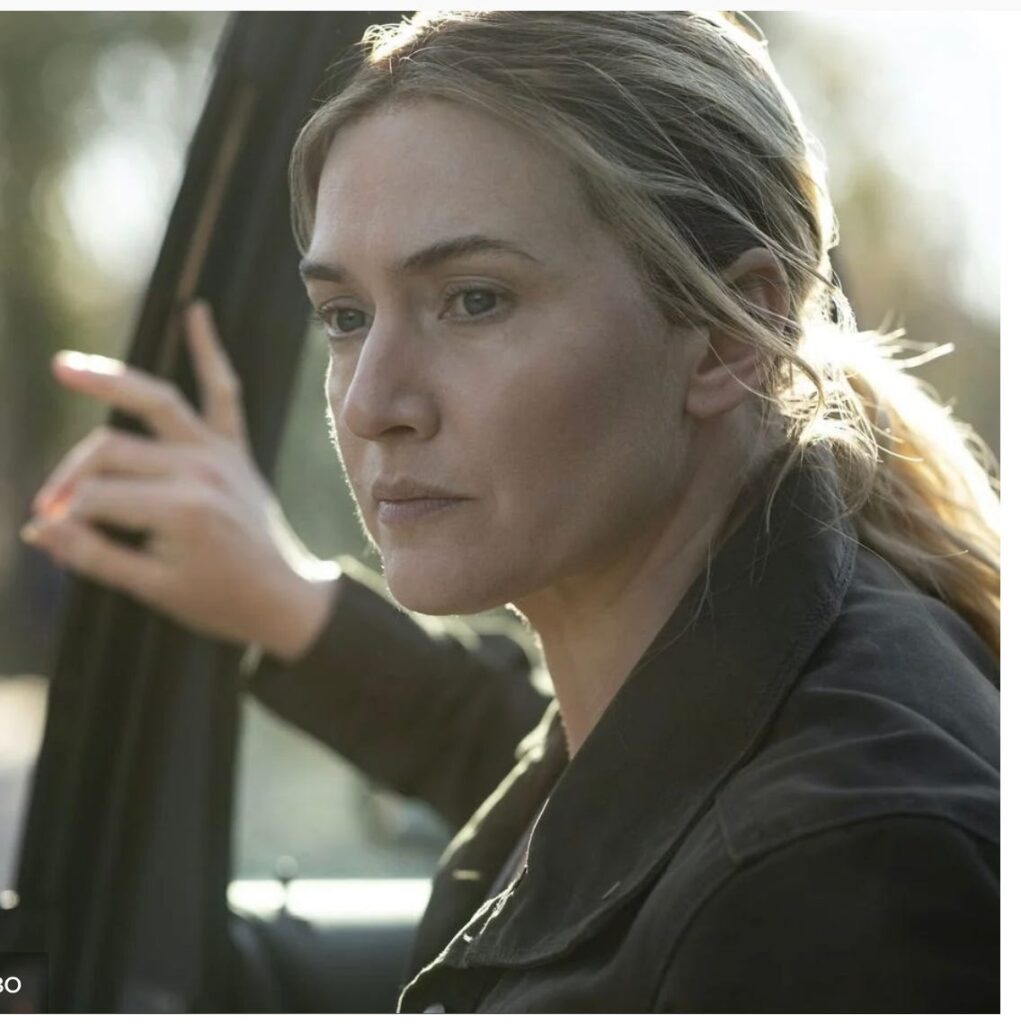Mare of Easttown is all of us.

Right about now, a great many Americans are bumping around in a melancholic fog, wondering how we, once so very sunny and optimistic, became so badly fried, so profoundly off, so obviously damaged. This is not the first time in 245 years that this has happened to us, but it’s a tribal habit to believe it so. No people on the planet have lost their innocence more times than Americans, who wake each morning oblivious to past sins, and go to bed every night changed forever by the latest adversity. There is something endearing in our New World habit of trying to impose meaning on trauma while it’s happening, because it is so childlike. How can we know what the disruptions of the past year, or the last hundred, signify? Still, we can’t help trying. Sifting through our stew of our popular culture, seeking signs, may be the real national pastime.
From this dangerous proximity, it’s easy to view Mare of Easttown, HBO’s crime miniseries starring Kate Winslet, which concluded its 7-episode run on May 30, as a symbol for our age. Like far too many of us, it feels bruised to aching. The fear among some executives was that Mare would be too grim for audiences worn down by bleak news. They needn’t have worried, because its central whodunit — the murder of still another lost, blameless teenage girl —was compelling, the acting, particularly from Winslet, Jean Smart, and Julianne Nicholson as the trio of mothers at the heart of the action, was brilliant, and the payoff surprisingly satisfying to all but the most jaded. Plucking very precise strings in dark times, it should surely win many Emmys.
Before Mare, most people could be forgiven for not knowing that southeastern Pennsylvania, more specifically Delaware County, just a skosh and Schuykill to the left of Philadelphia, a quirky adjacency like New York’s Nassau or London’s Essex, was a distinctive place, with an argot worthy of being lampooned on Saturday Night Live. Commentary about the “Delco accent”—specifically Winslet’s mastery of carelessly long O’s, and T’s that drum out like D’s—is everywhere. SNL tags the people of mythical Easttown, a grimy row house community lost somewhere between Drexel Hill and Coatesville, as “very specific whites— Pennsylvania whites,” but that’s lazy. Like much of postindustrial America, Easttown is multiracial, and while much has been made of its regionalism, it could stand in for any number of burnt-out exurbias in the Mid-Atlantic and industrial Midwest. Although it’s a straight shot down the White Horse Pike to the Jersey Shore, Easttown is in no way a coastal locale. It’s a point not infrequently made that such communities are rarely seen on American television. This is where Roseanne and The Conners get brought up, but situation comedy is a very different kettle of fish. Serious drama, featuring blue collar people, is far more common in Britain. After all we have been through on this side of the Atlantic, we remain unused to seeing ourselves so far out of the aspirational frame.
The police procedural is arguably the exception to this, but given the complicated politics around policing, it likely matters that Marianne Sheehan is a deeply flawed woman, as well as detective sergeant, a battered fortysomething raising her grandchild after her son’s suicide. The men of Mare are screw-ups, frauds and chaos-makers, and the Church has been badly compromised; it’s women who try to hold a fragile world together, attempting to mend what’s irreparable. The show’s creator, Brad Inglesby, was inspired by the tough women who were the bedrock of the Pennsylvania communities he grew up in. (For a lot of reasons, it would be hard to imagine a show called Mark of Easttown right now). The most powerful scene in Mare is the final climactic set piece between Winslet and Nicholson, in which the women, both mothers who have lost children and husbands, collapse together, one in torment, the other trying to soothe her. The men are gone; there is nobody else to lean on.
Critics have pointed out that Mare is not the first show to play dysfunction in a working class community as a sort of parable for what’s going badly wrong in the industrialized West. In particular, it is strikingly similar to Happy Valley, a British crime drama starring Sarah Lancashire as another world-weary middle-aged cop, raising a grandkid in a drug-ravaged town. Two other U.K. series, Broadchurch and The Bay, have effectively explored the darkness corrupting small town life, with a deeply flawed investigator who is also a struggling mother at the center of the mire. Still, Mare is something different, because she is an unidealized American mother, even if she is played by an Englishwoman, and her context—the hard America of the opioid crisis, of Trump, of Hillbilly Elegy listlessness and under-employment, is relatively novel. If she has a big sister, it is Frances McDormand in Nomadland, another tough, unvarnished, guarded woman, that persona tiresomely shorthanded as “a survivor.”
Unlike the deliberately meandering Nomadland, Mare is a well-plotted detective story (though a subtextual whodunit in both may be who killed the American Dream), and as such is part of a storytelling tradition that has always exposed our ugliness and hypocrisy. The hardboiled detective, that invention of early twentieth century pulp, and particularly the Anglo-American genius Raymond Chandler, was a gritty corrective to the polite drawing room mysteries of Dorothy L. Sayers and Agatha Christie. Winslet’s Marianne Sheehan has the wounded toughness of Phillip Marlowe, going down mean streets to bring justice to a debased world. Like Marlowe, she’s not as tough as she pretends, but unlike him, she has dependents. Chandler had a nose for the rot undermining the American Dream, but the stakes in the world of Mare of Easttown are higher; the traumatized heroine (and everybody else) hangs on by a thread.
Lugging all of this on her back with appropriate weariness, Winslet is nothing like the radiant ingenue first seen under an enormous picture hat 25 years ago in Titanic (though both characters do hail from Philadelphia). As often happens when beautiful actresses transform themselves into average-looking characters, too much has been made of this. She has bad roots and flannels from WaWa, but the characterization is far more in the bone. Winslet becomes a shambling, exhausted figure, walking with a heaviness that speaks to her grief. She is also bitingly funny, and her eyes have the wariness of somebody who is used to being betrayed. Early in the series, she must run down an addict who also happens to be the brother of a friend, and hurts her leg. Seeing Winslet hobble around, stealing hits from a vape pen, doesn’t feel so much like watching a performance as an evocation of the whole tired world as it is right now.
Inglesby intended the climax of his series to be capital “R” redemptive, and that it is. Damaged characters grope their way toward one another, and reach for something like mercy; if Mare has anything to do with it, somehow things will be patched together. Her boss at the station asks Mare if she is OK after all the tragedies she has recently witnessed, and she responds, “Not really.” His rejoinder, “But you’re going to survive,” is expected, and cathartic, and maybe even true.
There is some loose talk about a second season for Mare of Easttown, but it seems to be only that. The world may have moved into a brighter spot by the time it could be completed, but the greater mysteries — how do we bear grief, how do we weather all of this, and what can any of it mean — remain unsolved.
